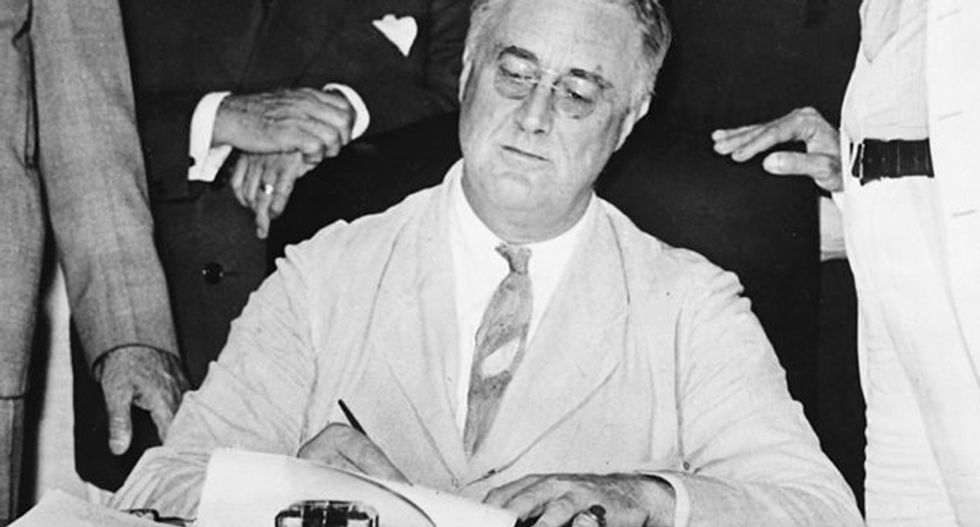Growing up in Texas, we were treated to stories of colorful political characters. Few could top John Nance “Cactus Jack” Garner, who once pronounced that the vice-president position “is not worth a bucket of warm spit.” (Some say Garner said worse.)
That seems to be the opinion of more than a few pundits and political scientists. National Public Radio, The Economist and Politico have all run articles asserting how little impact a vice presidential pick makes on the ultimate outcome of a presidential election.
I take a different approach, comparing vice presidential picks’ performance in their states to how the party did in that state four years earlier.
Vice presidential picks: a recent history
To test their hypothesis, I analyzed how a party’s presidential ticket performed in the vice president nominees’ state in a given election year. Then I compared it to how the party’s ticket did in that state four years earlier.
It turns out that more often than not, a vice presidential candidate running as vice president for the first time helps you perform better in his or her state than four years earlier when that VP candidate wasn’t on the ticket.
ALSO READ: Tim Walz's personal finances are extraordinarily boring — and that may help Harris
For example, did Mike Pence help Donald Trump’s performance in Indiana during 2016 compared to how Republicans did in 2012? This case matters, given that Democrats won Indiana in 2008.
By the same token, did Democrats do better in Virginia with Sen. Tim Kaine as Hillary Clinton’s running mate in 2016 than Democrats did in the same state during 2012?
In these most recent 17 cases, where the vice presidential nominee isn’t already a vice president running for reelection — such as Joe Biden in 2012 — the vice presidential candidate boosted the party ticket 10 times in his or her home state. On seven occasions, the VP candidate did not do as well for his or her party as the party did four years ago in the state.
There were three cases where the vice presidential candidate boost or drag on the ticket was less than a percentage point. Taking those three out means that on nine occasions, the vice presidential candidate improved the ticket in his or her state. In five cases, the VP candidate did not help the ticket in the state he or she is from.
The average boost a vice presidential candidate gets a ticket in his or her own state is 4.4 percentage points, when considering all 17 cases.
That difference definitely matters in 2024.
As recently as last month, some polls put Trump ahead of Biden in Minnesota, which Biden had won by about 7 percentage points in 2020.
With Biden off the ticket, the advantage has swung back toward Democrats, but Minnesota Gov. Tim Walz’s addition to the ticket Tuesday will all but ensure that Minnesota — a must-win for Kamala Harris’ presidential chances — stays blue.
In three cases (1976 Democrats, 1980 Republicans and 1992 Democrats), a vice presidential candidate helped flip a state. In 2016, Kaine boosted the Democrats in his swing state of Virginia in a tight election — Clinton won Virginia, even if she lost the election.
One should also consider the cases where a presidential candidate would have done much better, possibly winning the overall election, with a better vice presidential selection.
ALSO READ: Why ‘vanilla’ Tim Walz is the ingredient to beat Trump: Dem lawmakers
Imagine President Gerald Ford keeping Vice President Nelson Rockefeller — and winning New York in 1976. It could have meant the difference in Ford defeating Democrat Jimmy Carter and winning his own four-year term after assuming the presidency from disgraced Richard Nixon. Instead, Carter narrowly won New York — and the election.
It’s also hard to imagine Democrat Al Gore losing Florida with the highly popular Sunshine State politician Bob Graham — a senator and governor — in 2000. Instead, he picked Connecticut's Joe Lieberman.
Republicans would have almost certainly fared a bit better against Democrat Barack Obama with a ticket of John McCain and Tom Ridge of Pennsylvania in 2008, instead of McCain and then-Alaska Gov. Sarah Palin.
Sen. Rob Portman (R-Ohio) might have helped Mitt Romney in 2012, at least in Ohio.
Still need convincing?
Many others in the media and academia have challenged the idea that vice presidential picks matter.
The Economist takes issue with the notion that vice presidential nominee Lyndon B. Johnson delivered the 1960 election to John F. Kennedy, who edged out Nixon in one of the nation’s closest elections in history.
And they might be right, given that the only states that voted for Democrat Adlai Stevenson II in 1952 and 1956 were from the South. Yet Dwight D. Eisenhower, the Republican, did win Johnson’s home state of Texas in both elections, and Kennedy captured Texas in 1960.
In a recent interview with A Martínez from National Public Radio, professor Kyle Kopko at Elizabethtown College takes issue with the idea that a VP candidate can deliver an election:
MARTÍNEZ: All right. So if the Harris campaign is thinking about picking a VP candidate to help them carry one of November's swing states, what is your message to them? Kyle, let's start with you there.
KOPKO: Well, first of all, it's probably not going to happen. Whenever we estimate a number of statistical models dating back decades, it's pretty rare that we find a vice presidential candidate that can deliver a battleground state. And even if they could, then it really has to be the decisive state in the Electoral College really to make a difference. So you can think about this as lightning needing to strike ever just right for it to count in the presidential election.
In a Politico article two elections ago, Kopko and Christopher Devine go into more detail about their model.
They look at state-level election returns from 1884-2012. They also delve in public opinion polls from 1952-2008 to see how much a vice-presidential candidate means for their home state.
Here are their findings: “While presidential candidates typically enjoy a home-state advantage (approximately 3 points to 7 points), vice presidential candidates generally do not. In each of the three analyses described above, a presidential ticket performs no better in the vice-presidential candidate’s home state than we would expect otherwise. Statistically speaking, the effect is zero.”
It's not that Kopko and Devine are wrong, but they are looking at eras with many blowout elections.
Think of Republican victories from 1896-1908 (William McKinley, Teddy Roosevelt), 1920-1928 (Warren G. Harding, Calvin Coolidge), and 1952-1956 (Eisenhower), or Democratic dominance from 1932-1944 (Franklin D. Roosevelt).
It wouldn’t have mattered if you put Superman on the ticket for the losing side, even with the X-ray vision.
But in more recent years, with 24-hour media and social media coverage, we learn a lot more about Palin, Pence, Kamala Harris and Joe Biden than America ever heard about Thomas Marshall, Thomas Hendricks, Levi P. Morton or Allen G. Thurman in those days.
Legacy of Charles not-quite-in-charge
But in more recent years, from 1976-2020, one could say that it’s a whole new ballgame for vice presidential picks.
And the selections of J. D. Vance of Ohio and Walz of Minnesota are likely to have a much bigger impact than Charles Fairbanks, Charles G. Dawes, Charles Curtis, Charles W. Bryan and Charles L. McNary (all vice presidential picks between 1904-1940) ever did.
John A. Tures is a professor of political science at LaGrange College in LaGrange, Georgia. His views are his own. He can be reached at jtures@lagrange.edu. His “X” account is JohnTures2.



 The Onion founding editor Scott Dikkers. (Courtesy)
The Onion founding editor Scott Dikkers. (Courtesy) President Franklin D. Roosevelt signs the Social Security Act . (FDR Library Digital Collection.)
President Franklin D. Roosevelt signs the Social Security Act . (FDR Library Digital Collection.)